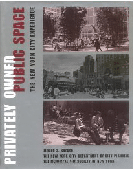
1114 Sixth Avenue
Public spaces and their surrounding neighborhoods are inevitably interdependent. Sometimes a public space can help define a neighborhood; sometimes a neighborhood overwhelms a public space. This half-acre, slightly elevated rectangular plaza at the southeast corner of Sixth Avenue and West 43rd Street dramatically illustrates the interdependency.

Although Bryant Park, the City-owned park one block south, is a stunning success, and nearby Times Square is a sizzling commercial address, it was not long ago that the two were havens of drug dealing and related street crime. Spillover of these activities to large privately owned public spaces at such buildings as Grace and Bell Atlantic was hard to fight. In 1985, 21 persons were arrested and many more made to line up, hands on planters or against the Grace building wall, in a police raid on drug use and sales in the space. An audit of the bottoms of planters at the Grace plaza in the late 1980s would yield dozens of empty multicolored crack vials in the dirt as continuing evidence of a losing battle.
It must first be observed that the initial design of the space hardly encouraged general public use. Produced under the lenient “as-of-right” standards of an earlier zoning era, the space was characterized by a vast emptiness wrapped in expensive marble tiles, a sun-deprived northern orientation, and a paucity of functional amenities that discouraged the broad public use that is the necessary, if not sufficient, condition for combating problematic users. The arcade space on West 43rd and 42nd Streets contributed little to the mix.
Still, the owner did employ management and design initiatives to fight the criminal takeover. It hired private security guards and off-duty police officers to patrol the space, with little success. One guard recounted, “You can get killed if you don’t know how to deal with [the dealers]. Don’t let them get to know you, don’t get friendly with them.” In 1981, the owner erected a spiked six-foot-high iron fence along the public sidewalk perimeters, claiming publicly that construction and demolition issues related to an adjacent building required that the public for its own safety be excluded from the space. As the fence lingered, however, it became evident that the owner had something else in mind than construction-related safety issues, and the City forced it to remove the fence.
The owner also developed a number of plans to renovate the space. One plan included a two-story retail arcade, another involved a food kiosk, water feature, and other amenities associated with urban plazas that would be provided in return for permission from the City to close the space at night. Unfortunately, a dispute on final terms for the nighttime closing doomed this plan.
One may wonder whether the plaza at Grace could have ever turned the tide on its own. After all, it took a bold mixture of out-of-the-box thinking, significant investments of public and private money, and invention of innovative public-private development and management vehicles to reinvigorate Bryant Park and Times Square. Today, the plaza here stands more or less as it was originally conceived and constructed. A double row of tree planters occupies the northeast corner. A stretch of benches along the northern edge and one long marble bench along the southern wall provide seating hardly conducive to socializing in that they make face-to-face contact difficult. A small utility building is found in the center. With the sea change in the neighborhood’s environment, the time is ripe for imagining once more a renewed Grace plaza.


 (2 votes, average: 3.50 out of 5)
(2 votes, average: 3.50 out of 5)
Grace Plaza is an unusual space to say the least. Situated at 42 West 43rd Street, this small, elevated concrete space sits in amongst five high rise buildings. The space is a concrete rectangle occupied by several stationary marble benches on its right peripheries and a giant glass box off to its left hand side. It’s not so much the location of Grace Plaza that makes it unusual, more so the feeling that it creates when one takes the time to sit in it. The domineering structures that surround the small space cause the area to feel enclosed, claustrophobic, and the occupants to feel insignificant, and out of place. The W. R Grace Building that the plaza is located in front of is an active office, which results in a constant flow of traffic leading both in and out of the building. Men in suits and women in blazers breeze through the space without taking a second glance at the people and objects that surround them in the Plaza. The space feels anonymous, it feels like you shouldn’t be there. Not only is this a feeling that is emitted from the individuals who work in the building, but the space itself makes you feel uncomfortable. The surfaces are all large and cold, the chairs are metal, the trees hilariously covered in fairy lights to distract from the reality that they are horrifically under-developed. The space feels empty even when people are in it, and it attracts a very specific person or persons to it. Mostly corporate, mostly well dressed, mostly caucasian, and mostly middle class. The space is a representation of modern corporate America. It tries to be something it’s not. Sitting in the space just makes you notice how you don’t belong there. Grace Plaza lacks life, it lacks personality, and it lacks humanity. The entire space is a variation of shades of grey, it’s not inviting, it’s not warm. People rarely stay for more than 10 minutes in the space, as if some unspoken timer goes off in their head telling them it’s time to move on. Whether this is intentional or not is impossible to know, but the result is the same. Grace Plaza does not want you to stay.